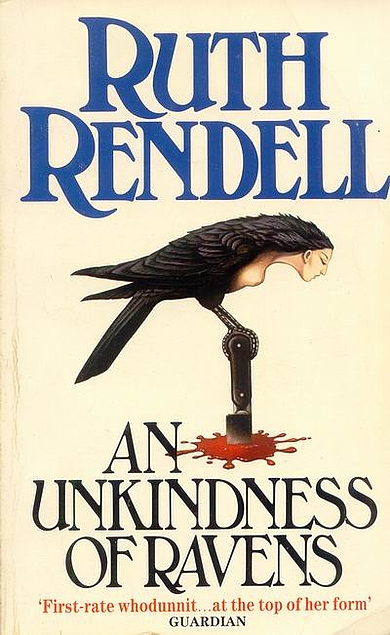Take a photo of a barcode or cover
A review by saareman
An Unkindness Of Ravens: by Ruth Rendell
3.0
A Muddle of Clues
Review of the Arrow Books paperback edition (1986) of the Hutchinson original hardcover (1985)
I read An Unkindness of Ravens as part of my ongoing survey of classic crime writing. Ruth Rendell (1930-2015) is especially known for the psychological elements in her crime fiction. Ravens at No. 13 is exactly in the middle of the pack of the 24 Chief Inspector Wexford novels. Wexford is somewhat of an old fuddy-duddy who is set in his ways and often quotes from theatre or the classics to the befuddlement of his assistant DI Mike Burden. Most of the sources of those quotes or allusions are never explained, so it is flattering to the reader who recognizes them. An example in Ravens is when Wexford refers to a Bunbury alibi with Burden's confused reaction. Bunbury being Algernon's fictitious friend who he uses for excuses in Oscar Wilde's [b:The Importance of Being Earnest and Other Plays|92308|The Importance of Being Earnest and Other Plays|Oscar Wilde|https://i.gr-assets.com/images/S/compressed.photo.goodreads.com/books/1260426623l/92308._SY75_.jpg|11094898] (1898).
At first you start to think that Ravens is going to be sympathetic to activist feminism which was beginning to rise to prominence in the late 1980s and early 1990's. The female characters though are almost all portrayed as unsympathetic with the final reveal of the murderer being quite diabolical. The red herrings of the case are mostly all related to a local feminist organization named after the rather contradictory historical suicide Arria in ancient Roman history. Then there are various curious Freudian and misogynistic subplots, Burden's wife is having a baby and fears that it will be born female etc.
So I can't really say that I enjoyed Ravens overall, except for Wexford's classical references and the twistiness of the plot.
Trivia and Link

I read An Unkindness of Ravens in its original 1986 paperback edition with its more evocative and theme appropriate cover art (pictured above) rather than the later 1990s edition which is used by Goodreads with a less specific cover art.
Review of the Arrow Books paperback edition (1986) of the Hutchinson original hardcover (1985)
I read An Unkindness of Ravens as part of my ongoing survey of classic crime writing. Ruth Rendell (1930-2015) is especially known for the psychological elements in her crime fiction. Ravens at No. 13 is exactly in the middle of the pack of the 24 Chief Inspector Wexford novels. Wexford is somewhat of an old fuddy-duddy who is set in his ways and often quotes from theatre or the classics to the befuddlement of his assistant DI Mike Burden. Most of the sources of those quotes or allusions are never explained, so it is flattering to the reader who recognizes them. An example in Ravens is when Wexford refers to a Bunbury alibi with Burden's confused reaction. Bunbury being Algernon's fictitious friend who he uses for excuses in Oscar Wilde's [b:The Importance of Being Earnest and Other Plays|92308|The Importance of Being Earnest and Other Plays|Oscar Wilde|https://i.gr-assets.com/images/S/compressed.photo.goodreads.com/books/1260426623l/92308._SY75_.jpg|11094898] (1898).
At first you start to think that Ravens is going to be sympathetic to activist feminism which was beginning to rise to prominence in the late 1980s and early 1990's. The female characters though are almost all portrayed as unsympathetic with the final reveal of the murderer being quite diabolical. The red herrings of the case are mostly all related to a local feminist organization named after the rather contradictory historical suicide Arria in ancient Roman history. Then there are various curious Freudian and misogynistic subplots, Burden's wife is having a baby and fears that it will be born female etc.
So I can't really say that I enjoyed Ravens overall, except for Wexford's classical references and the twistiness of the plot.
Trivia and Link

I read An Unkindness of Ravens in its original 1986 paperback edition with its more evocative and theme appropriate cover art (pictured above) rather than the later 1990s edition which is used by Goodreads with a less specific cover art.